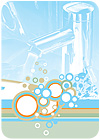
Plumbing engineers have long been aware of the benefits of electronic plumbing-improved water savings, better hygiene, easier maintenance, reduced housekeeping and vandal resistance, to name a few. These benefits, coupled with emerging technologies, which include the convergence of multiple systems into integrated networks, are pushing the plumbing engineer toward an expanded role in building system integration with water savings and hygiene as the focus.
Understandably, water savings (or hygiene for that matter) was not often at the top of a building owner’s list. Within the last decade, however, that has changed for a number of reasons:

- Water is one of our most precious resources. As the earth’s population continues to grow, our need for safe, abundant water supplies will increase. However, much of the world’s population lives in areas with limited water resources. With rainfall totals in recent years diminishing, many countries have experienced problems with droughts. In fact, the Climate Prediction Center’s “Drought Severity Index by Division” map shows that Montana and Wyoming cover a significant portion of the most severely drought-affected areas within the United States, as well as Arizona and other states in the region. These states must act quickly to expand their water conservation programs. (See sidebar, “Tackling Water Conservation from Every Angle.”)
- Water is getting more expensive. It is costing us more to supply, treat, dispose of and treat water again. The energy required to meet these demands is enormous and also carries with it an environmental price tag.
- Water conflicts are likely to become common in many countries. The study of future water availability, which corporations conducted over the past few years, suggests this. These analysts work for Shell, Coca-Cola, Procter & Gamble, Cargill and other companies that depend heavily on secure water supplies. (See the World Business Council for Sustainable Development study, which further suggests the next 20 years would be critical as countries become richer, making heavier demands on scarce water supplies.)
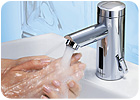
Whether the fixtures are battery powered, solar powered or hardwired, automatic faucets and Flushometers lead the pack when it comes to water efficiency. Reports abound of schools, hospitals, restaurants, office buildings…even prisons that have experienced significant savings due to the automatic control these products afford. Sensor faucets, which react to the presence of users, turn on and off automatically, saving 30% more water on average than manual faucets, while sensor Flushometers reduce water usage by 50% or more. In fact, one prison facility in California, where water shortages are an ongoing problem, reported an 80% reduction in system water usage-from 83,000 gallons to 42,000 gallons of wastewater each day.
A little harder to quantify, but equally compelling as a benefit of electronic plumbing fixtures, is better hygiene, as electronic fixtures minimize restroom touchpoints. This is a convenience that creates a positive impression in users’ minds-one that is rapidly becoming an expectation and a necessity.
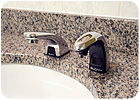
Reducing the Spread of Infection
It is well documented that the most important measure for preventing the spread of pathogens is effective hand washing. Hand hygiene is defined as any method that removes or destroys microorganisms on hands. According to the Centers for Disease Control and Prevention (CDC), proper hand washing requires the use of soap and warm running water and rubbing hands vigorously for at least 20 seconds, with close attention to the nail areas, as well as the area between the fingers.The amount of time spent washing hands is important to reduce the transmission of pathogens to food, water, other people and inanimate objects (fomites) such as plumbing fixtures, door knobs, hand railings and other frequently touched surfaces. In addition, wet hands have been known to transfer pathogens much more readily than dry hands or hands not washed at all. The residual moisture determines the level of bacterial and viral transfer following hand washing. Careful hand drying is a critical factor for preventing bacterial transfer to skin, food and environmental surfaces.
In fact, the CDC reports that improved adherence to hand hygiene has been shown to terminate outbreaks in health care facilities, reduce transmission of antimicrobial-resistant organisms (e.g., methicillin-resistant staphylococcus aureus) and reduce overall infection rates. By installing automatic water closet and urinal Flushometers, faucets, soap dispensers and hand dryers, restroom visitors can avoid touching potentially contaminated fixtures and reduce the chances of cross-contamination and infection.
In addition to improving hygiene, hands-free plumbing products ease
installation and maintenance. Many of these automatic fixtures are pre-plumbed
and pre-wired with electronic controls for quick installation and less need for
field adjustments. When maintenance is required, all components are easily
accessible, and self-diagnostic electronics (such as low-battery indicator
signals) make it simpler to keep fixtures in working order. The sensor
technology of these products has also been refined so that detection errors,
previously caused by lighting conditions and reflective surfaces such as
mirrors or stainless steel, have been eliminated.
Electronic plumbing also eliminates the opportunity for users to leave faucets
running or toilets unflushed. This reduces water consumption and housekeeping
chores, keeps odors to a minimum and decreases the incidence of clogged
toilets. Vandalism also becomes a non-issue without handles or knobs to kick or
damage. Rounding out the list of benefits is the fact that all sensor-operated
plumbing products meet ADA (Americans with Disabilities Act) accessibility
requirements. They also can help earn multiple points related to the Leadership
in Energy and Environmental Design (LEED®) Green Building Rating System.
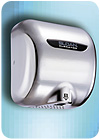
Next Generation
The benefits are plenty and make it clear that hands-free plumbing is here to stay, but these features are only part of the story. A new generation of electronic plumbing systems can provide building owners with maximum control of water consumption through the use of networked, programmable plumbing products. Therein is the opportunity to re-invent the role of the plumbing engineer. By combining advanced microprocessor technology, few moving parts and no mechanical metering devices, fittings and systems are available that allow a plumbing engineer to offer building owners substantial water savings, reduced maintenance and lower sewage costs. In a word, the new electronic systems provide “control.”Networked plumbing control systems are already in use at correctional facilities in the United States and have produced important results. For example, the previously mentioned California prison not only reduced water usage by 80%, but was able to curb fixture abuse and water damage using technology customized for their facility. Computerized control devices enabled plumbers and administrators to turn water on and off to any combination of toilets, sinks or showers and to program pre-set limits for plumbing fixture use.
Plumbers also were able to use a programmable Palm® Pilot to program the networked plumbing system from the field, rather than centralizing control on a desktop PC, as some other prisons had chosen to do. This feature provided valuable flexibility, so that changes could be made on the spot as the need arose. The networked plumbing technology enabled the prison to reduce mainline blockages in sewer lines that can occur when inmates act out by flushing plastic bags, mattresses or clothing to clog up the system.
While this type of flexible control system has provided secure, effective solutions for many prisons, it also may offer security with far-reaching possibilities in the not-so-distant future. Remotely monitoring select plumbing fixtures in a facility from a desktop computer, either in real time or on an automatic pre-selected basis offers a wealth of information to the building owner. In fact, proprietary research has already been conducted in this area with surprising results (e.g., for the first time, technology can open the “window” of fixture use and allow the plumbing engineer enhanced predictability in terms of water allocation and fixture usage patterns).
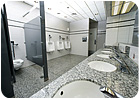
Even the Security Industry Association (SIA) has pointed out that integration means whatever the customer says it means. This leaves the door open for the plumbing engineer to advance the cause of water monitoring and bring it into the “integrated mode.” It will mean examining the use of a common protocol or computer language to interconnect systems from different companies in a plug-and-play fashion. Or it may require investigation of cutting-edge integration to develop quick and easy ways for other companies’ devices to interface or interconnect with each other. Suddenly, the plumbing engineer is an “electronic” engineer, or at the least, has to begin to speak the language of integration.
As the use of networked plumbing control technology is transferred to, and becomes more prevalent in, other types of facilities, the plumbing engineer’s role in the building system integration process must be reevaluated. Traditionally considered last in the phrase “mechanical-electrical-plumbing” (MEP), the plumbing engineer can no longer act in isolation during the building system integration process.
The rank of “P” in the MEP acronym is gradually shifting, and with good reason. By taking the lead in integration, the plumbing engineer can extend the control and security provided by networked electronic plumbing technology to all aspects of the building system. This is a coming event that the plumbing engineer should embrace as an opportunity.
Sidebar: Tackling Water Conservation from Every Angle
Just as the plumbing engineer’s role is expanding beyond fittings and fixtures to building system integration, water shortages in the United States are prompting legislation and development of water conservation programs on a larger scale.On the federal level, the Environmental Protection Agency’s (EPA) Water Efficiency Program (designated as a residential labeling program) has established voluntary specification criteria for a High Efficiency Toilet (HET). The specification includes a performance standard in addition to maximum consumption levels based on Uniform North American Requirements. Fixtures that meet the guidelines of the EPA will need to comply with the labeling program, which is intended to help educate consumers.
In California, anticipated population growth is putting significant pressure on
the state’s limited water supply. To help avoid shortages in the future, the
California House passed Appropriations Bill 2496 (AB 2496), which requires all
tank-type water closets installed in new buildings after Jan. 1, 2008, to use
no more than 1.3 gpf (4.9 Lpf). Flushometer water closets would be allowed to use
no more than an average of 1.3 gpf effective Jan. 1, 2009. On the same date,
newly installed urinals would have consumption limits of 0.5 gpf/1.9 Lpf. The
bill allows the use of dual-flushing technology, which represents a ratio of
1:2, and calls for easy-to-understand labeling for all water closets and
urinals.
[Editor’s Note: Although AB 2496 was passed by the California House, California
Gov. Arnold Schwarzenegger did not sign the legislation, stating that, “This
issue is best left to the California Building Standards Commission…to lead an
investigation into how best Californians can integrate water-saving technology
into our homes and commercial buildings.”]
Texas lawmakers passed Senate Bill 1094 that was signed on May 20, 2003, by the
governor to create the Water Conservation Implementation Task Force (WCITF). In
Sept. 2004, the task force members submitted its “Best Management Practices
Guide” to the legislature. The report specifies optimal levels of water use and
gives recommendations to achieve water efficiency in the state. The WCITF
recommends implementing Toilet Performance Standards to ensure that toilets
“cannot be retrofitted so that they waste water.”
In New Mexico, Katherine Yuhas, water conservation officer, Albuquerque
Bernalillo County Water Utility, cites education, along with enforcement and
incentive, as the three elements of a successful conservation campaign. In a
presentation titled, “Water Conservation in a Southwestern Community: Where
We’ve Been and Where We’re Going,” Yuhas calls for the establishment of a
citizens’ advisory board to ensure community needs are met, in addition to
working with existing community organizations to promote programs through
already-established networks.